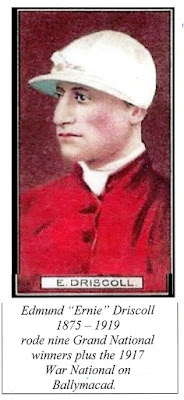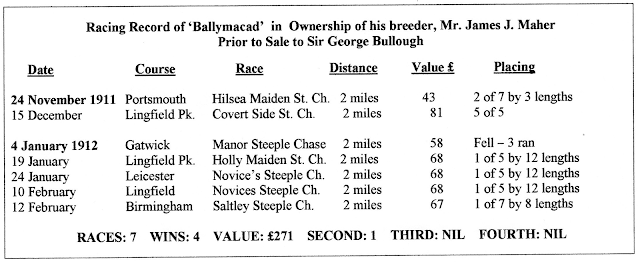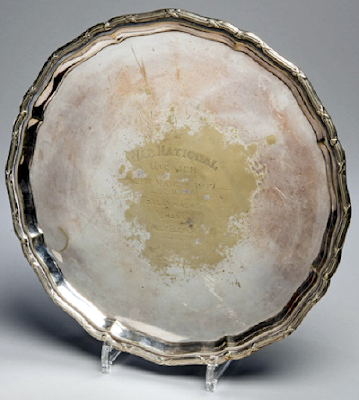Ballymacad, bred by
Mr. James J. Maher at his Confey Stud in County
Dublin, Ireland, was purchased by
Sir George Bullough in late February 1912 for £2,000 after
easily winning his
previous four races each over two miles.
The 1917 “War
National” Steeplechase at Gatwick
was Ballymacad’s fourteenth race in Sir George’s colours.
*
LAVENO (Ballymacad’s Sire)
Bred
by the Duke of Westminster
- Owned by Mr. J. H. Houldsworth.
 |
| Laveno (Sporthorse-Data) |
Laveno a bay colt born in 1892 by Bend Or out
of Napoli by Macaroni.
His sire, Bend
Or, a chestnut born 1877 by Doncaster out
of Rouge
Rose, was bred and owned by Hugh Lupus Grosvenor, 1st Duke
of Westminster. Bend
Or had
ten wins from his fourteen starts, including the 1879 Chesterfield Stakes and
Richmond Stakes, the 1880 St. James’ Palace Stakes and Derby Stakes and the
1881 City and Suburban Handicap and Champion Stakes. He finished a
good second to Robert the Devil, (winner in 1880 of the St. Leger
Stakes and Ascot Gold
Cup), in the Champion Stakes.
Bend Or died on 10
January 1903.
Other paternal
sires of note in Laveno’s pedigree include Lord Exeter’s Stockwell
(1849), winner of eleven races from thirteen starts including the St. Leger
Stakes and
2,000 Guineas Stakes; The Baron (1842)
winner of the St. Leger Stakes
and Cesarewitch Stakes; Teddington (1848)
winner of the Derby Stakes,
Doncaster Cup and the Emperor of Russia Cup;
and Thormanby (1857)
winner of the Derby Stakes, Gimcrack
Stakes and Ascot Gold Cup.
Laveno stood at
Eyrefield Lodge, Curragh Camp, Ireland to a
“limited number of approved mares”.
His fee in 1904 was 45 guineas plus one guinea for the groom.
Of his progeny
his fillies proved better flat racers than his colts,
his sole classic
winner being Topstone, born 1901, in the Irish Oaks.
His daughters
were especially successful as brood mares,
with the bay colt Craganour out
of Veneration by Desmond winning the
New
Stakes, Champagne Stakes, Middle Park Stakes and Newmarket Stakes.
Craganour was
exported to Argentina where
he proved himself a great stallion.
The fillies Glorvina, born 1911
by Desmond, won the Ascot Gold Vase and
Nassovian, born
1913 by William the Third, won the Princess of Wales’ Stakes.
Laveno was in the
league of Top Twenty Winning Sires three times
and headed the list in 1903.
In addition
to Ballymacad, Laveno sired several successful
steeple chasers,
including: Lavisher, Last Hope II and Laveline.
His flat race winners including:
Laveno Mare born 1906, Lavetta born
1908, Lavaine a colt born 1909,
Lavanda a
filly born 1910 and Laveno
II born 1910, the latter selling for
340 guineas after winning the Long Course
Selling race at Newmarket
in May 1913. Laveno died on 12
August 1909 at the age of seventeen.
BALLYMACARNEY (Ballymacad’s Dam) - Owned by Mr. James J. Maher
Born 1897 by Royal
Meath out
of Cinnamon by Concha, Ballymacarney’s paternal
sires of particular note include Lord Henry Chaplin’s Hermit (1864)
winner of the 1867 Derby Stakes, a powerful horse of exceptional confirmation
who suffered from Epistaxis, bleeding from the nose; Newminster (1848)
winner of the 1851 St. Leger Stakes; Melbourne (1834)
a leading sire in Britain with a gentle disposition and the propensity to pass
on good feet and legs; Neasham (1848) who ran a good third to Teddington in
the 1851 Derby Stakes and Champion Sire Touchstone (1831)
winner of the St. Leger Stakes, Doncaster Cupand Ascot Gold
Cup on two occasions.
Ballymacarney
foaled several other steeple-chase winners, including Ballyhackle born
1903, Ballymaccoll born
1904, Ballymadun born
1906 and Ballyhist born
1908.
Ballymacarney, covered by St.
Gris (by Galopin),
“the property of
Mr. James J. Maher”, was sold at Messrs Robert J. Goff & Company’s Blood Stock Sale
at the Curragh, Ireland, on 18 April 1912
to Mr. F. Hardy for 130 guineas.
Ballymacarney did not foal any flat race winners.
****** * ******
Following
purchase by Sir George Bullough in early 1912,
Ballymacad was
entrusted to thirty-four year old the
Honourable
Aubrey Craven Theophilius Robin Hood Hastings,
third son of the
Thirteenth Earl of Huntingdon,
at his Barcelona
Yard Stables, Wroughton, Wiltshire,
to be trained as
a steeple chaser.
Aubrey Hastings
was an all-round horseman;
an excellent
polo player who won the All Ireland Open Cup,
Rugby Open Cup,
Roehampton Cup, County Cup,
and Junior Championship at
Roehampton.
Sir George
clearly chose his trainer well.
Hastings was
already an established rider and manager of steeple
chasers,
having trained and ridden Prussian Prince Franz von
Hatzfeldt’s Ascetic’s Silver
to success in the 1904 Irish Grand
National and, after a false start,
the Grand National
in 1906. He also trained Lady Nelson's Ally Sloper
Grand National
winner in 1915
and later Lord Arlie's Master Robert, the 1924 winner.
THE 1917 “WAR NATIONAL” STEEPLECHASE (HANDICAP)
Winner to
receive £1,065 and a Cup value £100,
added to a Sweepstakes of £20 each
acceptor. For 5 year olds and upwards.
Second receives £100, and third £50
out of the race; entry fee £5.
(Racing Calendar - Steeple Chases Past - 1917 - Weatherby & Sons)
For the second year running hostilities necessitated the Grand
National to be transferred from its home course at Aintree, Liverpool, to
Gatwick Racecourse, near London, the land today being part of Gatwick
International Airport.
 |
The 1917 War National Trophy.
The lid inscribed “Ballymacad
Winner War National 1917.” |
Run under National Hunt Rules and called the ‘War National’
Steeple Chase (Handicap), the Gatwick course was 4 miles 856 yards long, the
same as at Aintree. Open to horses of five-years-old and upwards, the winner to
receive a purse of £1,065 and a Cup value £100, second £100 and third £50,
added to a Sweepstakes of £20 each acceptor.
The “Chronicle” reported
that “the obstacles had been stiffened considerably for the race, as was the
case last year. The Gatwick Course comprises twenty-nine jumps, one less than
at Aintree, and on both courses the open ditches are taken seven times and the
big water jump once. (At Gatwick) the water jump is three feet high with a
thirteen foot width of water against at 3 feet 1 inch and 16 feet at Aintree.”
Bitterly cold, with snow falling at frequent intervals between all
too brief moments of sunshine, the going was officially described as “heavy
with intermittent snow showers”. The nineteen runners out of an entry of
thirty-eight, described by the Sporting Chronicle as “the cream of jumpers from
all over the country”, lined up ready for the “Off” on Wednesday 21 March,
1917, the First Day of Spring!
At the “Off” it was Major D. Dixon’s “brilliant cross-country
performer” eight-year-old Irish bred bay gelding Templedowney by Bushey Park
out of Galway Girl, winner of the 1915 Scottish Grand National run at Ayr, Scotland, (who subsequently
fell), ridden by Thomas Hulme carrying 175-lbs at 25/1, who led for the first
mile with forty-two year old Edmund Walter Driscoll in the cerise, purple
sleeves and cerise cap colours of Sir George Bullough bringing up the rear on ten year old bay gelding Ballymacad,
carrying 138-lbs. at 100/9.

No change occurred until passing the stand for a second time when
Mr. D. Stuart’s seven-year-old bay gelding Carrig
Park by Succoth or Bushey Park out of Ardcarrig, ridden by Charles Hawkins carrying 160-lbs. at 7/2 also
fell. Colonel Birkin’s nine-year-old bay mare Queen Imaal by Denis Richard
out of a mare described as “by Brown
Prince” at 25/1, who eventually finished sixth, and Mr. G. Jones’
twelve-year-old bay gelding Blow Pipe
by Bird of Paradise out of Ballista at 40/1, who finished fifth,
then headed Templedowney, who shortly
afterwards regained the lead.
Seven furlongs from home Ballymacad
and Blow Pipe raced past Templedowney who fell soon afterwards.
At the final fence, Mr. E. W. Paterson’s seven-year-old American
bred bay gelding Limerock by Rock Sand** out of Annoy Lyle at 40/1, ridden by William J. Smith, jumped into the
lead but slipped and fell a few yards after landing.
Ballymacad went on to win by eight lengths from Mr. H. Trimmer’s seven year
old Chang by Cupid out of Threnody ridden
by William Smith carrying 135-lbs. at 11/2, in 10 minutes 12.4 seconds, an
average speed of 26.4 mph. Lady Nelson’s eight-year-old bay/brown gelding Ally Sloper* by Travelling Lad out
of Sally in our Alley at 20/1, ridden
by Ivor Anthony carrying 164-lbs. at 20/1 and Aintree Grand National winner in 1915, was third by four lengths.
 |
Open Ditch at Gatwick.
Mr. P. F. Heybourne’s seven-year-old bay gelding Vermouth by Barcadaile out of a dam by Bushey Park at 8/1 finished fourth, Blow Pipe fifth, Colonel R. L. Birkin’s nine-year-old bay mare Queen Imaal by Denis Richard out of a dam described as “by Brown Prince” at 25/1 sixth, Lord Suffolk’s eight-year-old chestnut gelding Father Confessor by St. Gris out of Entrenous at 40/1 seventh, Mr. H. Trimmer’s nine-year-old bay gelding Charlbury by Succoth out of May Hack by Hackler at 40/1 eighth and Lord Lonsdale’s six-year-old chestnut colt Yellow Chat by Chatsworth out of Yella at 100/12 in ninth place, followed by Mr. Eric Platt’s ten-year-old Irish Mail second by two lengths to six year old Vermouth in the 1916 Racecourse Association Steeple Chase, and Mr. F. Bibby’s twelve-year-old Thowl Pin who was unplaced in 1916. |
 |
Two of the four racing plates worn by
Ballymacad Winner of War National 1917.
|
Of the nineteen starters, eleven successfully completed the
course.
Sir George Bullough’s second entry, ten year old Denis Auburn by General Peace or Denis
Richard out of Auburn’s Pride ridden
by thirty-two year old Roger “Tiny” Burford carrying 144-lbs. at 40/1 was one
of the nine horses recorded as falling or being “pulled up.” The others being: 8
year old Templedowney, 10 year old Hackler’s Bey, 8 year old Gristhorpe, 7 year old Limerock, 8 year old Kenia, 7 year old Carrig Park, “who had been brought over from Ireland at the
beginning of the Hunt season and won three races right off against good fields,
his last six efforts resulting in as many wins”, and Mr. P. S. Adams’ 7 year
old chestnut gelding Fargue.
 |
Sir George Bullough gave his winnings to
St. Dunstan's Hospital
for blinded soldiers and sailors. |
* NOTE: Ally Sloper by Travelling Lad out of Sally
in our Ally, born 1909,
was sold as a yearling by Mr. C. J. C. Hill at the
Doncaster Blood Stock Sale on Thursday 8 September 1910 to Mr. Sugden Armitage for 25 guineas.
His first steeple chase was at Newbury on Wednesday 27 November 1912 in the
Hamptonshire Maiden Hurdle Race in the name of Mr. H. Randall.
There is no
record of a public sale to Lady Nelson in whose name Ally Sloper raced from 1913, winning the Grand National in 1915.
**
Exported to America, English Triple Crown winner Rock Sand, born 1910, was a paternal grand sire of Man o’ War
and sire of Teabiscuit dam of Hard Tack, sire of Seabiscuit.
 |
| The Paddock at Gatwick. (Photograph by Chris Pitt) |
 |
| GWR RESEARCH ARCHIVE |
 |
NOTE: There is
no record of Ballymacad racing in 1914 or 1915
in The Racing Calendar for 1914 or 1915 (steeplechases or
flat races)
published by Weatherby and Sons for the Jockey Club.
GWR RESEARCH ARCHIVE |
* * * * * * * * *
The 1918 Gatwick
War National Meeting, also a mixture of races over the flat and jumps, was held on
Wednesday and Thursday 20 and 21 March.
The substitute Grand National ran on second day as
the War National Steeple Chase (Handicap) and attracted
thirty-eight entries
of which
seventeen ran. Conditions were described as “Good Going”.
Following his success in 1917, Sir
George Bullough entered Ballymacad,
now eleven years
old and his nine year old, Simon the Lepper.
Ballymacad finished
third and Simon the Lepper eighth.
 |
Gatwick Course and Grandstand on Race Day.
The Bandstand was relocated to Queen's Square, in nearby Crawley
where it is still in use.
(Condo Hotel Centre)
|
1918 “WAR NATIONAL” STEEPLE CHASE
(HANDICAP)
DETAILED
REPORT COMPILED BY GEORGE W. RANDALL
- Copyright © GWR Research Archive -
Sir George Bullough entered 11
year old Ballymacad ridden by Ivor
Anthony carrying 157-lbs. at 7/1 and 9 year old Simon the Lepper, ridden by Roger Burford carrying 140-lbs. at
50/1.
*
For the third successive year
hostilities prevented the Grand National being held at Liverpool, where
the Aintree course remained under requisition by the War Ministry.
Gatwick Racecourse therefore
again hosted the substituted ‘War National’ Steeple Chase (Handicap), the
length of the course being the same as at Aintree, 4 miles 856 yards and run
under National Hunt Rules.
Conditions were declared good as
the seventeen runners from an entry of thirty-eight took their starting
positions on Thursday the 21 March 1918 for another First Day of Spring
National.
At
the “Off” all made a good clean break.
At the second fence Lady Nelson’s
eight-year-old bay/brown gelding Ally Sloper
by Travelling Lad out of Sally in Our Alley at 5/1, (winner in
1916 and 3rd in the 1917), blundered, unseating his jockey,
John Walsh, who remounted to finish sixth.
Captain Brian Bibby’s seven-year-old
brown gelding Wavertree by Wavelet’s Pride out of Kendal Lily at 5/1, ridden Edmund
Driscoll who rode Ballymacad to
victory in 1917, fell at a small obstacle preceding the Ditch. Mr. H. Trimmer’s
ten-year-old bay gelding Charlbury by
Succoth out of May Hack by Hackler at
33/1 then led Mr. F. R. Hunt’s ten-year-old bay/brown gelding Captain Dreyfus
by Santoi out of Madame Dreyfus at 20/1, who finished second, Mr. F. W. Parnell’s
eight-year-old chestnut gelding Top Hole
by Caedmon out of Childish at 50/1, Mr. H. Denison’s ten-year-old
bay mare Queen Imaal by Denis Richard out of a dam described as
by Brown Prince at 50/1, Ballymacad and the ultimate winner, Mrs.
Hugh Peel’s eight-year-old bay gelding Poethlyn
by Rydal Head out of Fine Champagne at 5/1 etc.
After the first ten furlongs Captain Dreyfus headed Charlbury.
At the water jump, Top Hole jumped into the lead.
There were no further changes
until they passed the stands for the second time when Charlbury briefly regained the lead before falling.
Entering the straight the pace of
Queen Imaal, Top Hole, Mr. P. F. Heybourn’s eight-year-old bay gelding Vermouth by Barcadaile out of a dam by Bushey
Park at 12½/1, Mrs. Douglas Stuart’s eight-year-old chestnut gelding Sergeant Murphy by General Symons out of Rose
Graft at 40/1, and Mr. F. S. Watt’s eight-year-old chestnut gelding Chang by Cupid out of Threnody at 12½/1, all collapsed, leaving Captain Dreyfus clear of Poethlyn.
Two fences from home Poethlyn, trained by Mr. H. Escott,
ridden by Ernest Piggott, (grand-father of Lester Piggott), carrying 160-lbs.
at 5/1 jumped into the lead ahead of Captain
Dreyfus.
Poethlyn went on to win by four lengths in
9 minutes 50.4 seconds, from Captain
Dreyfus with Ballymacad in third
place by over a distance.
Mr. Barclay Walker’s
seven-year-old bay gelding Berneray
at 100/7 was fourth, Mr. Ernest Salter Wills’ seven-year-old chestnut colt Mark Back by Marcovil out of Oliveback
at 40/1 fifth, Chang sixth, Vermouth seventh, Sir George Bullough’s
second entry, Simon the Lepper at
50/1, ridden by Roger Burford finished eighth and Mr. T. M. McAlpine’s
seven-year-old bay gelding Shaun Spadah
by Easter Prize out of Rusialka at 10/1 in ninth
place.
Of the seventeen starters, two,
namely Ally Sloper and Wavertree, fell.
[Poethlyn also won the 1919 National,
making three National wins for
Ernest Piggott - 1912, 1918 and 1919.]
 |
Gatwick Racecourse Paddock Inspection. (Collector-Sport, Croydon)
*
It is
regrettable historians of this world famous steeplechase choose not to
recognise the 1916, 1917 and 1918 races run in the middle of the Great War,
descriptions and even the results often being omitted from lists of winners.
Grand
National purists could not be more scathing about the three “War Time” Grand
Nationals, dismissing them as the “three so-called substitute races……run on a
course bearing no resemblance to Aintree……”
|
























































